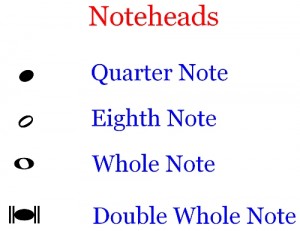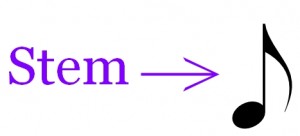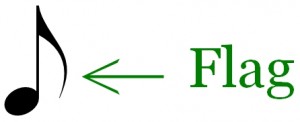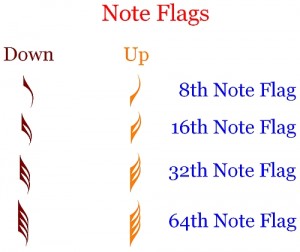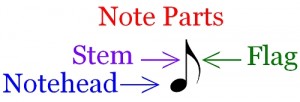Musical Note Symbols
Musical Note Symbols and Note Values
The musical note is the foundation setting forth the shape of musical notes as used in music composition. Note shapes and values assist in designating them apart from one another and for naming them. Note shapes are placed on a musical staff and are used to designate pitch and duration when placed on the musical staff. In order to begin your understanding of music notation one must begin with the very basic knowledge of the musical note and note values based upon the note’s shape. You must be able to recognize them from their shape and be able to use the notes knowing how to use them with an understanding of their meaning and purpose. Further, you must be able to work with them in order to create your own music. This information will go a long way in helping you to know and understand music as it is written under today’s accepted notation standards and practices.
Metaphorically, as is the case for any adventure, that very first step is always the hardest one to take. You would think that just picking up your foot, moving it forward or backward using your leg muscles and then setting it back down again would be something we could learn easily but then again, how long did it take for you to take your first step?
Music writing or composing is sort of like that. If you are just starting out, it may take you a while to write your first notes or to create your first song even with the glorious hope and high anticipation that this newborn music may be your first masterpiece.
…or, you could be a professional composer or songwriter anxiously waiting to begin filling in the notes of a blank page of manuscript paper resulting in an exquisite work of musical grandeur fit for a Royal Court, the Grammy Awards, your mother or maybe placing high up on the Billboard Charts.
In either case the composition begins with a single note of music strategically placed on a musical staff. With that said, let’s take a look at musical notes and their respective shapes.
The Musical Note and Note Heads
If we begin by looking at what a note is or what it signifies we can begin to learn to read and write music. I mentioned this point several times in my article The Grand Staff – Music’s Secret Stairway – the Grand Staff Part 1 and Part 2 however these comments were made in a broader sense. In this article we are going to get considerably more basic, specific and elementary for those new to music notation and for those who wish to learn or fill in any gaps which may be present in your collection of existing musical knowledge.
The musical note has three components, the notehead, the stem and for notes with a value of an eighth note or smaller, a flag of various designs. A fourth consideration is what to do to tie them together.
The first chart shows the most common noteheads used in music notation.
Each notehead shape is distinct and different than the others. Descriptions of the noteheads are provided below. There are many additional notehead types which will be presented in future articles. For now, let’s take a quick look at the components of the notes design. We will be using an eighth note for the following presentations of the components of the musical note.
When assembled, the notehead has three main components, the first is the notehead itself. Our previous chart demonstrated the most commonly used noteheads.
The stem ties the notehead to the third component, the flag.
The flag is used on all notes beginning with the eighth note and for all notes with a shorter duration. The chart below demonstrates the use and the design of various note flags.
There are additional musical note values which add another flag for each as follows; the 128th note, 256th note and the 512th note. These notes are rarely used but they are available to use should you compose music which requires them. It is important to delineate between flags pointing down versus those pointing up. This distinction is relative to the note direction as will be seen in a chart later in this post.
Note Shapes – One important detail and concept to know is that a musical note is basically a graphical representation of a sound or collection of sounds as in the case of chords, musical phrases, passages or entire compositions. The graphical shape for a single note provides to a performer some instructions as to its relative value. Both pitch and duration are represented once a note is placed on a staff of music. These instructions or notes enable the proper performance of the music.
It is the shape of the note that describes its duration however the actual clock time duration is not represented in the notes shape, only its relationship to other notes of differing values; whole note, half note, quarter note, etc. and then in relation to the tempo of the music.
It is the actual placement on the staff that gives the musical note its name or identifies its pitch.
Musical Note Shapes
Below are several graphical note shapes with a brief explanation of each. Learning them will help you to understand some of the “tools” needed for music composition. Since we discussed pitch in a separate article, Basic Characteristics of Sound we will be focusing on note duration as represented in the graphical shape of the musical note and its relationship to note values or duration as described in this article. However, once a musical note is placed on the staff, it also provides the note name as equated to its pitch. In that regard it is relevant to reference in this paper.
 The note shape above is a whole note on a five line staff. Notice that it is similar to a squashed circle or an oval and it uses a thicker line then the next symbol we will show, the quarter note. The notehead is hollow or not filled in. Also, it does not have a stem as is seen in other note shapes and it lays flat when placed on a line or in a space of the staff.
The note shape above is a whole note on a five line staff. Notice that it is similar to a squashed circle or an oval and it uses a thicker line then the next symbol we will show, the quarter note. The notehead is hollow or not filled in. Also, it does not have a stem as is seen in other note shapes and it lays flat when placed on a line or in a space of the staff.
This note shape above shows the half note. The line is thinner than the one used to create the whole note. Notice that the notehead is hollow and not filled in the same manner as the whole note. The notehead shape is different, distinctions are important in music composition. The addition of a stem, the line going down from the left side of the notehead, is the amended design. This new design has a different duration and note value as compared to the whole note. Also, make the observation that the notehead is on a 45 degree angle rather than laying flat.
The note shape above shows the quarter note. It is very similar to the half note however take notice that now the notehead is filled in. That is the only difference between these two note shapes, the half note and a quarter note.
 The note shape above shows an eighth note. Notice that it is different than the shape of a quarter note where a flag is added creating a different note duration, the eighth note. The flag begins at the bottom of the stem moving upwards and touching the notehead using a curvy line. The curvy line is on the right side of the stem in this example. An example of an eighth note where the flag is on the left is shown below in the graphic describing stem direction, shown later in this article.
The note shape above shows an eighth note. Notice that it is different than the shape of a quarter note where a flag is added creating a different note duration, the eighth note. The flag begins at the bottom of the stem moving upwards and touching the notehead using a curvy line. The curvy line is on the right side of the stem in this example. An example of an eighth note where the flag is on the left is shown below in the graphic describing stem direction, shown later in this article.
When placing more than one eighth notes next to one another in the same measure of music, on the same beat or on multiple beats, the graphical presentation changes as is shown below.
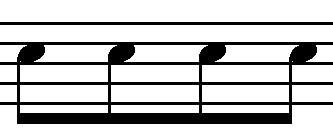 Notice that the flag changes its shape so more than one eighth note can be literally tied together within the same or multiple beats using a single darker line. When multiple notes are tied together all of their stems touch this solid line. The darker line replaces the flag found on a single eighth note.
Notice that the flag changes its shape so more than one eighth note can be literally tied together within the same or multiple beats using a single darker line. When multiple notes are tied together all of their stems touch this solid line. The darker line replaces the flag found on a single eighth note.
 The graphic above shows a sixteenth note. The only difference between an eighth note and a sixteenth note is the addition of one more flag.
The graphic above shows a sixteenth note. The only difference between an eighth note and a sixteenth note is the addition of one more flag.
Similar to tying together more than one eighth note, the sixteenth notes graphical shape changes as follows when tying two or more of them together.
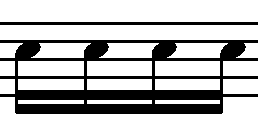 Notice that the sixteenth notes are tied together using two heavy lines as opposed to only one as used for the eighth note. Again, the flags are replaced by two solid lines.
Notice that the sixteenth notes are tied together using two heavy lines as opposed to only one as used for the eighth note. Again, the flags are replaced by two solid lines.
If you were to add another flag to the sixteenth note you would have a thirty second note. Still further, by adding another flag to the thirty second note you end up with a sixty fourth note, etc. When tying them together a thick line is added each time you decrease the note value. Also, when an additional flag is added, such as in the case of creating a thirty second note, you must add another line so the thirty second note has three lines tying them together and a sixty fourth note has four lines, etc.
Stem Direction – In music notation, notes are placed on the staff in a specific way. The middle line of the five line staff is sort of a marker for determining which direction the stems go, up or down. When a note is placed below the middle line the stems go up and when placed on or above the middle line they go down. The graphic below shows the difference. A quarter note in the example.
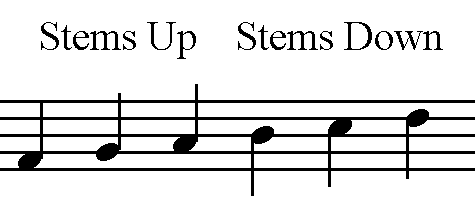 As you can see the general appearance of the quarter notes remains the same and the only difference is the direction of the stem. This is the general rule of thumb regarding the proper placement of the stems, however there are instances where it does not hold true.
As you can see the general appearance of the quarter notes remains the same and the only difference is the direction of the stem. This is the general rule of thumb regarding the proper placement of the stems, however there are instances where it does not hold true.
You may want to make an additional distinction. Notice how when the stem is going up it is placed on the right hand side of the notehead. It is reversed and placed on the left when the stem is pointing down.
Musical Note – A Philosophical Comment
Comment – Here is an interesting thought – a composer has in his or her mind an idea for a new composition. He can be visualizing it or hearing it either internally, within his or her head, or they can be inspired by some external environmental experience when making observations or gaining inspiration from the inside world. In both cases, at that moment, the musical idea or observation is an intangible “thing” or quite simply, a thought. You can’t put a thought in a wheelbarrow now. Can you?
In order to bring the music into the world one has to either perform it or write it down otherwise it remains just an idea (…and you thought I was joking). In both instances, the act of performing and/or writing the music down on paper is in essence supporting the act of creating music. Having a standardized collection of symbols makes it possible for the general population to come to know and to create music through either reading it or by writing it using the standards accepted in the music industry and in academia.
Within this article we are discussing the act of writing out music, music notation using standardized notation practices. In addition to composers, the symbolic language of music is also used by conductors, musicians and performers and a host of others working with the language of music. The note shapes assist the performer by directing them with specific instructions on how to play each note of music. The composer uses specific note shapes to provide those instructions through the use of music notation for the benefit of the performer.
The conductor reads and interprets the written instructions from the composer’s manuscript and then conveys his or her understanding of the composer’s intention to the performers or instrumentalists. Hopefully, if this is all done well, the end result is the full manifestation of the musical message the composer wishes to convey through his or her music, to their listening audience. This is all made possible simply due to a musical thought that was written out for others to enjoy.
Tools – An excellent carpenter usually has a lot of tools in his tool belt and/or toolbox in order to create the desired construction project. As an example, when a plane is needed to smooth and level a piece of wood, the carpenter reaches into their toolbox and retrieves one. The carpenter may have several planes in which case he or she needs to select only one of them, the proper one, to do the specific task needed to be done. When a drill is needed they do the same and so the story goes for each of the carpenter’s tools. Likewise, an excellent composer has many tools to choose from when creating the desired musical work. Note shapes are only a small part of the overall tools available to a composer and they are a vital part at that.
Musical Note – Sound Characteristics – Duration and Pitch
In my article about the Basic Characteristics of Sound we specifically talked about the four characteristics relative to sound that influence its perceived character. Let’s think about two of these characteristics for a moment, duration and pitch.
Duration – The sound characteristic of duration can be conveyed and/or learned by knowing the shape of the musical notes being used to create the notation of the composition. There are two aspects to the sound characteristic of duration. One of those aspects is the measure of how long the note sounds in actual clock time. By itself, this is not designated by note shapes so much as it is measured and typically stated by the tempo designation shown on the top left of a manuscript of music or over a staff line if the tempo changes somewhere during the course of the composition. It does however have an impact and strong influence on the perceived length of a note relative to time but this aspect is not the exclusive factor for note duration.
The other aspect of this characteristic of sound can be measured or determined by the note shape as we presented earlier. The note shape tells us how long to hold the note as it sounds during playback relative to the other notes used in the composition. Note duration is also influenced by the time signature used in the song and by the designated tempo in the score. The actual note shape specifically helps us to know a note’s duration relative to the other note shapes used within the composition.
Pitch – I want to add that another relative sound characteristic heavily influenced, in fact dictated by a note when placed on a five line music staff, it is called pitch. (If needed, please review the article about sound characteristics and specifically about pitch for an overview).
For this article simply remember that where a note is placed on the staff denotes its name not its duration. In that sense you can come to realize that the characteristics of sound can be shown through music notation and that each is influenced by and influences other characteristics of the sound as it is played from music notation. All of this leads us to learning the magic behind music notation. Each characteristic requires specific shapes or graphics to be drawn and placed on the musical staff in specific locations in order to create and properly represent the music we wish to notate.
These two types of sound characteristics can be demonstrated using shapes or drawings which supply the basis of the meaning of a note in music notation. One influences the note length or duration, its shape, and the other designates its pitch, its name. Consequently it is vitally important to know your musical “tools” in order to create the desired performance of the music you intended on writing. Keep in mind that the tempo of the music also influences the actual clock time for each note. We will be reviewing that concept a little later.
Back to Note Duration – Let’s take this one step further, say for example that you needed a longer sounding note and a shorter sounding note for representing the sound you hear in your head and that you wish to write them down. Each has to be somehow graphically different in order to delineate which is which, as related to duration. Consequently you use the whole note shape for representing the long sound and the quarter note shape to represent the shorter length of the sound. This was demonstrated using the graphical representation of the musical note values above. However, how does that relate to the relationship of each note shape to one another?
For reference: The length of actual clock time for a musical note is set by the tempo designated by the composer and it is used for either the entire work or for specific passage, phrase or section within the composition. The tempo is the rate in which the music is performed. It is measured in beats per minute of clock time. Musical note shapes only determine the length of a specific note relative to other note shapes. The actual length of a note’s duration is determined by a collection of factors. Those factors are; the tempo, the time signature and the actual musical note shape.
Musical Note – Shape Relationships
Remember, two key topics help us to define the relationship between the duration of the note shape and how they relate to one another. Earlier we discussed clock time as being different from note duration based upon the musical note shapes. We will leave that explanation in place for now. We must also consider the impact of a note’s duration with another concept known as the time signature.
Time Signature – At the beginning of each piece of music or at various locations within a musical composition a composer uses a time signature to designate the number of beats in a measure of music and which note shape receives one beat of time. The graphic below is an example of a 4/4 time signature.
 The first symbol is the G clef or treble clef shape. The second symbol is the time signature of 4/4. The top number represents that there are four beats to a measure of music. The bottom four represents that a quarter note gets one beat.
The first symbol is the G clef or treble clef shape. The second symbol is the time signature of 4/4. The top number represents that there are four beats to a measure of music. The bottom four represents that a quarter note gets one beat.
You may want to review part one and part two of Music’s Secret Stairway – The Grand Staff Part One to get the basic idea of the use of a treble clef symbol. It will be helpful to fully understand this article. Also, you may want to review Speed in Music – Tempo to clarify your understanding of tempo as different from duration.
Why are time signatures important to consider when composing music and what influence does it have on selecting appropriate musical note shapes?
The time signature basically lays out the number of beats each measure holds and so it is vitally important to understand them as well as how to use them to gain the effects you seek when composing music. Secondly, it describes what note shape completely fills in the amount of time a note is to sound for each beat.
 The graphic above shows one measure of music in 4/4 time. I have selected the quarter note to place on the staff in the position which gives the note shape the name of “C” note. The 4/4 time signature designates four beats to a measure and a quarter note gets one beat. Thus four quarter notes, needed to fill in the time requirement as designated by the 4/4 time signature, are placed on the staff. The idea of time signatures is more fully explained in our article series Time Signatures – Music Theory – Part 22a. There are many time signatures and one must learn and study them to be effective when composing music.
The graphic above shows one measure of music in 4/4 time. I have selected the quarter note to place on the staff in the position which gives the note shape the name of “C” note. The 4/4 time signature designates four beats to a measure and a quarter note gets one beat. Thus four quarter notes, needed to fill in the time requirement as designated by the 4/4 time signature, are placed on the staff. The idea of time signatures is more fully explained in our article series Time Signatures – Music Theory – Part 22a. There are many time signatures and one must learn and study them to be effective when composing music.
Back to our lesson. If I were to select an eighth note rather than the quarter note the graphic above would look like this instead –
 The requirement of four beats per measure remains, however there are now 8 note shapes rather than four. Because there is a difference in the duration of the note shape of a quarter note and that of an eighth note it is necessary to fulfill the time signature’s requirements with the number of note shapes needed to do so. When using eighth notes we need to place eight notes in each measure of music to meet the 4/4 time signatures requirements. This tells you that there is a relationship between the note shape of a quarter note and the shape of an eighth note. That relationship is easy to see when observing these graphical representations of this concept. In essence the relationship of an eighth note as compared to a quarter note is 2:1. That is, two eighth notes are equal in duration as one quarter note.
The requirement of four beats per measure remains, however there are now 8 note shapes rather than four. Because there is a difference in the duration of the note shape of a quarter note and that of an eighth note it is necessary to fulfill the time signature’s requirements with the number of note shapes needed to do so. When using eighth notes we need to place eight notes in each measure of music to meet the 4/4 time signatures requirements. This tells you that there is a relationship between the note shape of a quarter note and the shape of an eighth note. That relationship is easy to see when observing these graphical representations of this concept. In essence the relationship of an eighth note as compared to a quarter note is 2:1. That is, two eighth notes are equal in duration as one quarter note.
The Influence of Tempo on Duration – To overlay the idea of clock time onto this explanation one must place a tempo marking to designate the number of beats per minute. The impact is significant again as can be learned from the following examples.
Using your eyes follow along reading the musical notes and using your ears listen for the speed or rate of each note as it sounds.
In this first example the demonstration is both audio and visual to assist us in learning more specifically the differences created by manipulating the tempo as related to the various musical note shapes.
Adagio 60 means that notes are performed at a rate of 60 beats in a minute. Certainly these two measures do not represent one full minute of music. Rather the rate at which each note shape is played is at the rate equivalent to 60 beats per minute even though only eight notes are to be played. The rate is constant unless the composer makes another tempo mark altering this rate somewhere in the score.
Using Adagio 60 as our beat per minute rate you will notice the clock time used for playing the quarter notes during the performance of these two measures of music. Click the mp3 player to listen to the actual sound of the notes as written in the chart. You will be able to hear the specific effect of both the tempo rate and the quarter note shape as it sounds in the 4/4 time signature. These effects or influences will be better understood when looking and when listening to the mp3. There is no curser to follow so you will need to look and listen simultaneously. Don’t worry, you can play it as many times as needed for you.
This second example demonstrates the use of the eighth note shape still in 4/4 time and at the same Adagio 60 tempo rate (beats per minute). Do you hear how the influence of changing only the note shape drastically changes the actual sound you hear as compared to the quarter note example. Play each audio file repeatedly until you recognize this difference. Please, this is important. Thanks!
Now let’s listen to the impact of changing the tempo by designating the rate at Presto 160 beats per minute while using the same quarter note and eighth note layouts as we did before. You may want to play the audio file where we used the tempo of Adagio 60 against the Presto 160 tempo to fully understand and appreciate the influence of tempo (or clock related time) on the note shape. The note shapes are not changed but the change in tempo is altering how we perceive the value of the quarter note shape or the eighth note shape. We can in this way learn to delineate between short spans of time while associating the note duration in a visual way through the musical note symbols you have been reading about. Pretty cool!
Now, the note shape in the above chart, has not been altered except and only by the tempo being adjusted to 160 beats per minute. Consequently, the actual amount of clock time to perform the same note values in relation to the change in tempo decreases, which proves to us that the note shape is not the only determining factor of duration based upon its shape but rather by additional factors as well. This one factor, as demonstrated here, is tempo. Let,s double check using eighth notes instead to see if this works out the same or not.
Here is the eighth note shape at the Presto 160 tempo rate.
Again you may want to play the eighth notes at Adagio 60 against those at Presto 160 to fully verify the influence of clock time or tempo on these note shapes. Also, to be thorough play the quarter note Presto 160 example against the eighth note Presto 160 example. Also, mix it up by playing the quarter note Adagio 60 sample against the Presto 160 using the eighth note. What did you discover?
At this point you should have a very good understanding of the influence tempo has on the note shape. Let us now proceed to review the relationships of note shapes still using the 4/4 time signature. To spread these ideas out a bit.
Remember, in 4/4 time a quarter note gets one beat and there are four beats to a measure. What this graphic does is to provide a better explanation for you in your effort to understand duration and the related note shapes in our examples. Referencing the chart above look at each musical note shape in its own measure and then read about each note shape below. Also, visually compare each measure to the other measures. This will help to more fully understand the use of the note shape and its relationship to the other note shapes.
Whole Note – The whole note in 4/4 time gets the equivalent of four beats per each whole note or one note is performed in a single measure of music. The whole note is shown in the first measure above.
Half Note – The half note in 4/4 time gets the equivalent of two beats or two notes per single measure of music. Two half notes are equal to one whole note. The half note is shown in the second measure above.
Reference: One Whole Note = Two Half Notes
Quarter Note – The quarter note in 4/4 time gets the equivalent of one quarter note per beat of music or four notes per measure of music. Four quarter notes are equal to one whole note. Two quarter notes are equal to one half note. The quarter note is shown in the third measure above.
Reference: One Whole Note = Four Quarter Notes
Reference: One Half Note = Two Quarter Notes
Eighth Note – The eighth note in 4/4 time gets the equivalent of ½ of a beat and there are eight notes per measure of music. Eight eighth notes are equal to one whole note. Four eighth notes are equal to one half note. Two eighth notes are equal to one quarter note. The eighth note is shown in the fourth measure above.
Reference: One Whole Note = 8 Eighth Notes
Reference: One Half Note = Four Eighth Notes
Reference: One Quarter Note = Two Eighth Notes
Sixteenth Note – The sixteenth note in 4/4 time gets the equivalent of ¼ of a beat or 16 notes per measure of music. 16 sixteenth notes are equal to one whole note. 8 sixteenth notes are equal to one half note. 4 sixteenth notes are equal to one quarter note and two sixteenth notes are equal to one eighth note. The sixteenth note is shown in the last measure above.
Reference: One Whole Note = 16 Sixteenth Notes
Reference: One Half Note = 8 Sixteenth Notes
Reference: One Quarter Note = 4 Sixteenth Notes
Reference: One Eighth Note = Two Sixteenth Notes
Referencing back to the chart above, the musical note duration relationships are represented and can be easily understood when comparing one measure to the others. Regardless of the tempo designated for the music, the note relationships remain the same. The only difference is the length of clock time each note shape consumes.
Perceived Speed – At the risk of redundancy, one whole note played in 4/4 time and four quarter notes also played in 4/4 time are equivalent as related to the relationship of a quarter note to a whole note. Since the tempo of the music is not a factor for note shape relationships, it requires no further discussion here beyond what has already been covered earlier in this article. However, because the rate or tempo dictates the length of clock time for a single beat, designated and measured in beats per minute, music can be perceived to sound faster when using smaller note durations than when using the notes which represent longer durations when played at the same tempo. This is simply due to the fact that there are more notes being played in the same actual clock time for a single beat within a measure of music. In actuality the tempo is the same, the performer is just busier playing the sixteenth notes because there are many more of them to play as opposed to playing half notes or whole notes within the same actual clock time for one beat of music. Again this was demonstrated earlier. You can also get more information by referring to Speed in Music – Tempo article for more information about this distinction.
At this point you should have a thorough understanding of musical note shapes, the duration of each note shape and the influences of time signatures and tempo on the actual clock time duration of a note. Feel free to stop in any time to review this article.
There are many ways to graphically display the relationships of note values. By performing a Google search you will find a variety of graphical examples should you need additional input. My intention was to keep this explanation linear and as simple as possible, from a graphical standpoint, and I hope this works to assist you in your understanding of musical note values based upon note shapes.
The musical note and note values play a vital role in music notation. In fact, it is one of the most important and yet it is the most basic fundamentals of writing music.
Credits – All graphics and sound samples for his article were created in the Sibelius 6 Music Notation Program. Sibelius is a product of Avid.
The Musical Note

